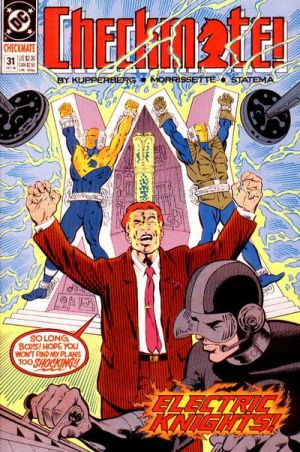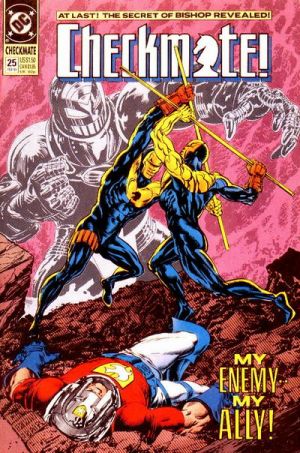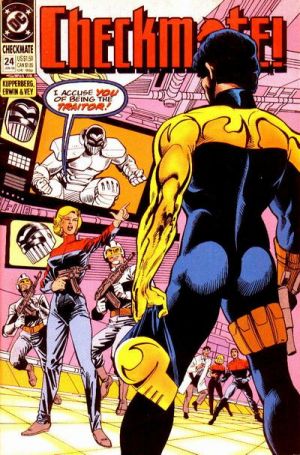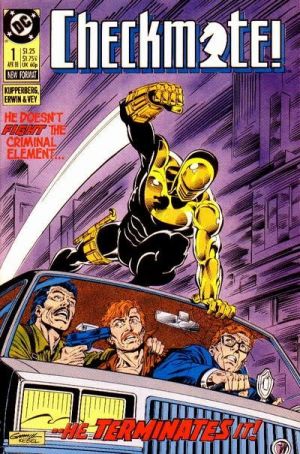Comics /
Back Issues
All the King's Men: Checkmate! (1988)
By Josh Dean
September 4, 2011 - 11:07
While the differences between the Marvel and DC Universe are not drastic, DC (for most of its publishing history) lacked a strong counterpart to Marvel’s SHIELD organization. There were little stabs here and there for far-reaching spy organizations but none really caught on. With the success of John Ostrander’s Suicide Squad series, and (one would have to imagine) the surging popularity of Tom Clancy, the powers that be greenlit Paul Kupperberg and Steve Erwin’s Checkmate! (I am excluding the exclamation from here on out) in the late 1980s.
Based loosely on the Agency (a pseudo-SHIELD outfit from Marv Wolfman’s Vigilante run), Checkmate was DC’s group of super spies- the James Bond franchise to Suicide Squad’s Dirty Dozen. The idea was pretty neat and simple, the King and Queen ran the organization (in this case Harry Stein- a Vigilante supporting character, and Amanda Waller of Suicide Squad fame). There seemed to be only one Bishop, Harvey Bullock (yeah, the slightly crooked slob from Batman). Knights were the field agents, given to wear almost identical costumes and rotated in regards to storylines. Rooks were the handlers and coordinators of field operations and pawns were support staff like scouts and getaway drivers. Their missions were pretty firmly grounded in real life threats like terrorists and arms dealers.
 |
As a kid, I found Checkmate too wordy and the characters too anonymous to get into. Recently having acquired the complete run, I decided to give it another chance. The opening year of the series (the strongest), reads like a James Bond comic book. One Knight per mission is sent in to, say, bust up a white supremacist movement that is planning to wage war on the government. Another goes after an arms dealer in the Middle East. The missions are varied and exciting in their execution, with random happenstance making the best laid plans more complicated. Some Knights don’t make it out alive and, slowly, Kupperberg begins revealing a Keyser Soze like enemy behind many seemingly unrelated threats.
Granted, the sprawling cast keeps anyone but Harry Stein and Harvey Bullock from being well developed. If one were reading these month to month, I can’t imagine how you would keep the Knights straight or develop a favorite (having read all 33 issues in a row, all I can say is there is a black one, a French one, a British one, a woman and an Irish one- none of their names are recalled). As the story is set in a superhero universe (and seems really invested in cleaning up loose ends from Vigilante) there is a loose cannon character named Black Thorn who keeps running into and against Checkmate. Her character is very close to what later portrayals of the Huntress ended up as. She goes from enemy to ally and finally member of Checkmate but there is an overarching plot with her that never gets resolved due to cancellation. Also, the old Charlton character, Peacemaker, became an occasional ally. I was unaware that part of his deal was him talking to his dead Nazi father all the time like an inverse Dexter so I was very confused as to why everyone but him was ignoring this SS Officer hanging around Peacemaker’s base.
Things start going off the rails in year two. First, the Invasion crossover forces itself into two issues (11 and 12). Issue eleven is about a group attempting to oust the British government. And, oh yeah, they are loyal to the alien invaders or something. It has nothing to do with Invasion and just seems like the alien references were shoe-horned in. Issue twelve is all about alien loyalists trying to sabotage a shuttle mission. Both stories could have run without the Invasion banner at all and I doubt new readers were pleased with getting suckered into this very non-science fiction reading.
 |
Not two issues pass and then the Janus Directive arrives. This was a mini-crossover aimed at a very specific corner of the DCU. Mainly running through Checkmate and Suicide Squad, this tale of Kobra and his attempts to aim a giant laser at Earth spread into Manhunter, Firestorm and Captain Atom. The big, splashy action kills off most of the Knights (except the ones we have gotten to kind of know) and shakes up a title that was really still finding its legs. It also introduces a villain named Bishop and a huge continuity error- more about which later. The crossover really does affect the rest of the series as it is continually referenced throughout the rest of the run. However, it also marks a turning point away from the original formula of mission of the month and into more incestuous plots as each issue revolves around figuring out which of the Knights is Bishop and having Harry Stein’s sons kidnapped. The overarching plot of the master villain of the series comes into more focus but, at that point, the series becomes another standard superhero comic with more reliance on Peacemaker and an effort to give each Knight a distinct look.
Most of the remainder of the series is spent trying to draw out Mr. Cipher, the villain of the piece. His end game is a ridiculous takeover of a foreign country that leads into a three issue conclusion to the series. Sometime in the early 20s, series artist Steve Erwin leaves the title for awhile. His work had been detailed but unremarkable. It was pretty much a perfect fit for the realistic grounding of the stories. Then, Tom Grindberg (drawing very much in the style of Neal Adams) comes on board and, while the art is more pleasing, a disturbing trend develops….cover spoilers. Be warned, the next few sentences deal with 20 year old spoilers. A long-running mystery throughout the second year of Checkmate is that of the identity of Bishop, an armored assassin who keeps running afoul of our heroes. They drag out the investigation issue after issue until it is down to two Knights (the French one, with dark hair, and the Irish one, with brown curly hair) who had been left for dead during earlier adventures and both returned mysteriously to rejoin the organization. The cover of issue 24 shows a Rook revealing that a Knight with dark hair is Bishop. We don’t find out until the end of issue 25 that Bishop is the dark haired French Knight. So, all dramatic tension is just gone.* Speaking of which, the cover of the issue where Harry Stein tries to get his kids back from being taken hostage shows his son being shot. Guess how the issue ends? With that same son being shot. Why give away the dramatic climax of the issue on the cover? Seems like a waste.
 |
As all books with no real hook eventually go the way of cancellation, so too did Checkmate. Cipher did not prove to be a very engaging enemy and all the insular storylines drew away from the broad, exciting scope of the first year of stories. Later, Greg Rucka would resurrect the concept and give it a fresh spin by making the Kings and Queens recognizable characters like Alan Scott and Mr. Terrific. The political manoeuvring and multiple agendas became the selling point but that series lasted even fewer issues than Kupperberg’s. Checkmate now exists as the go-to spy agency in the DCU. If the DEO is the FBI, these guys are the CIA. This was a fascinating series and, I’m sure, a hard sell to audiences in the late 1980s. If it hadn’t run out of steam, it could have been very engaging and ultimately more satisfying than it turned out. I would recommend this for Clancy enthusiasts and, even then, only through the Janus Directive.
*As a digression, the revelation that the French Knight is Bishop makes no sense whatsoever. His motivation for becoming Bishop is that he felt betrayed by Checkmate when Kobra attacked him and he was left for dead during the Janus Directive. Unfortunately, Bishop first appeared before Kobra began taking out Checkmate agents so, I don’t get it.
Last Updated: January 17, 2025 - 08:20



